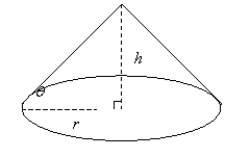A granular substance such as sand naturally settles into a cone-shaped pile when poured from a small aperture.Its height depends on the humidity and adhesion between granules.The angle of elevation of a pile, θ, is called the angle of repose.If the height of a pile of sand is 11 feet and its diameter is approximately 34 feet, determine the angle of repose.Round answer to nearest degree. 
Definitions:
Nuclear Weapons
Explosive devices designed to release energy in an explosive manner as a result of nuclear fission, fusion, or a combination of both, used by military forces.
Foreign Policy Powers
The authority granted primarily to the executive branch of a government to guide international relations, negotiate treaties, and conduct diplomacy.
Nuclear Arms Race
The competition for supremacy in nuclear warfare between countries, notably between the United States and the Soviet Union during the Cold War, characterized by the rapid development and testing of nuclear weapons.
Soviet Union
A socialist state that existed from 1922 to 1991, officially known as the Union of Soviet Socialist Republics (USSR), comprising multiple subnational Soviet republics.
Q16: Use the value of the trigonometric function
Q36: When two railroad tracks merge, the overlapping
Q49: Evaluate the trigonometric function using its period
Q57: Write an equation for the function that
Q65: Ed gives Steve land with an adjusted
Q67: The committee that is responsible for holding
Q85: Identify which of the following statements is
Q153: Evaluate the expression.Round your result to two
Q177: Use a graphing utility to graph the
Q241: Use a double-angle formula to rewrite the